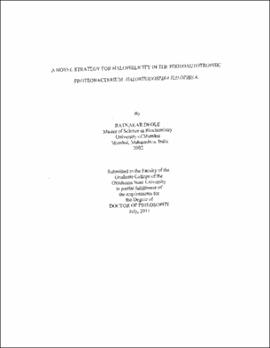| dc.contributor.advisor | Hoff, Wouter | |
| dc.contributor.author | Deole, Ratnakar | |
| dc.date.accessioned | 2013-11-26T08:22:51Z | |
| dc.date.available | 2013-11-26T08:22:51Z | |
| dc.date.issued | 2011-07 | |
| dc.identifier.uri | https://hdl.handle.net/11244/6639 | |
| dc.description.abstract | Scope and Method of Study: Approximately 97% of all water on earth is present in saline oceans, saline lakes, inland seas, and saline groundwater. Additionally salt deposits occupy one quarter of the land on earth. Thus, saline and hypersaline environments are highly abundant and of great ecological significance. In addition, salinity is a major determinant for microbial community composition. Therefore, halophilic adaptations are of general biological interest. Extreme halophiles thrive in hypersaline environments by accumulating molar amounts of potassium chloride or compatible solutes in their cytoplasm. Here we studied the osmoprotection strategy of the extremely halophilic purple photosynthetic y-proteobacteria H halophila and H halochloris. Genes involved in osmoprotection were studied by bioinformatic analysis of the H halophila genome. Proteome acidicity, which is generally associated with the use of KCl as a major osmoprotectant, was studied through calculated average pl of the predicted proteins and isoelectric focusing gel electrophoresis of total cellular proteins. Cytoplasmic KCl and glycine betaine concentrations were quantified using plasma emission spectrometry and colorimetric assay. Electron microprobe elemental analysis was used to observe cytoplasmic KCl content. | |
| dc.description.abstract | Findings and Conclusions: The work described here demonstrates that H halophila breaks away from the current understanding of halophilic adaptations. It has an acidic proteome, but can function in the absence of increased cytoplasmic KCl concentrations when cells are grown at low NaCl concentrations. H halochloris, a close taxomoic relative of H halophila, does not accumulate KCl, which indicates recent rapid evolution in osmoprotection strategy. This is matched by the broad distribution of pl values of its proteome as revealed by gel electrophoresis. Interestingly, H halochloris uses the organic osmolyte glycine betaine as its main osmoprotectant. H halophila can also perform glycine betaine biosynthesis and uptake from the medium through its uptake systems. This was demonstrated by checking the stimulation of cell growth by addition of glycine betaine to H halophila cells grown under K+ limiting conditions and salt stress. H halophila does not confer with the two known halophilic strategies. It uses an unusual mixed KCI/compatible solute strategy for osmoregulation, with an osmoprotectant switch near 1 g/1 KCl in growth medium. The average K concentration of the Wadi Natrun lakes from which H halophila was isolated is close to the concentration at which it switches to the 'Low-salt, osmolyte-in' strategy of osmoprotection. Hence we propose this switch in osmoprotection strategy is ecologically relevant for survival of H halopila. | |
| dc.format | application/pdf | |
| dc.language | en_US | |
| dc.rights | Copyright is held by the author who has granted the Oklahoma State University Library the non-exclusive right to share this material in its institutional repository. Contact Digital Library Services at lib-dls@okstate.edu or 405-744-9161 for the permission policy on the use, reproduction or distribution of this material. | |
| dc.title | Novel strategy for halophilicity in the photoautotrophic proteobacterium Halorhodospira halophila | |
| dc.contributor.committeeMember | Burnap, Robert | |
| dc.contributor.committeeMember | Mostafa, Elshahed | |
| dc.contributor.committeeMember | Hadwiger, Jeffrey | |
| dc.contributor.committeeMember | DeSilva, Udaya | |
| osu.filename | Deole_okstate_0664D_11563.pdf | |
| osu.accesstype | Open Access | |
| dc.type.genre | Dissertation | |
| dc.type.material | Text | |
| dc.subject.keywords | extremophiles | |
| dc.subject.keywords | glycine betaine | |
| dc.subject.keywords | halophiles | |
| dc.subject.keywords | halorhodospira | |
| thesis.degree.discipline | Microbiology and Molecular Genetics | |
| thesis.degree.grantor | Oklahoma State University | |
